
Key Developments
- Present Significance: As the massive interstellar object 3I/ATLAS completes its close flyby of Mars, a fleet of international orbiters is capturing potentially world-changing data that could determine if it is a natural phenomenon or an object of intelligent design.
- Striking Fact: Harvard astrophysicist Avi Loeb notes the object’s trajectory is a staggering statistical longshot, with its alignment and timing for planetary flybys having a combined likelihood of just one in a million (×0.005=0.00001), fueling speculation about its origins.
- Next Step: The world now awaits the public release of high-resolution images and spectroscopic data from NASA and other space agencies, which will provide the first clear look at the object’s nucleus and chemical makeup.
WASHINGTON D.C. – A mysterious and colossal object from beyond our solar system is currently under intense scrutiny as it traverses our celestial neighborhood, prompting a tense debate between leading scientists and government officials. The object, designated 3I/ATLAS, made its closest approach to Mars on Friday, October 3, presenting a golden opportunity for humanity’s robotic emissaries to capture unprecedented data. But as the world’s space agencies aim their instruments, questions and controversy are growing here on Earth.
At the heart of the debate is Dr. Avi Loeb, the head of Harvard’s Galileo Project and a renowned, often outspoken, astrophysicist. In a startling interview on Newsmax, Loeb detailed what he calls “seven anomalies” concerning 3I/ATLAS, suggesting its characteristics challenge a purely natural explanation. His appearance, shared with Rep. Tim Burchett (R-TN) of the House Oversight Committee, has elevated the object from a scientific curiosity to a matter of national interest.
Compounding public concern, the official response has been viewed by some as dismissive. In a separate news segment, White House Deputy Chief of Staff for Policy, Stephen Miller, was pressed on whether the President has been briefed on 3I/ATLAS. Miller, while addressing the ongoing government shutdown, assured Americans that the nation’s top experts are monitoring the situation and that there’s nothing to fear. However, the host’s unconvinced reaction mirrored a growing public sentiment that the full story is not being told.
Dr. Loeb’s analysis presents a compelling case for skepticism. 3I/ATLAS is not just another wandering comet. It is estimated to be at least a thousand times more massive than the two prior confirmed interstellar visitors, 1I/`Oumuamua and 2I/Borisov. Its nucleus is believed to be over 5 kilometers in diameter. Most perplexingly, its orbital path is a statistical marvel.
“We are fortunate to benefit from the passage of an unusually massive and bright interstellar object,” Loeb stated, before laying out the incredible odds. He explained that its orbit aligns almost perfectly with the ecliptic plane—the flat plane where the planets orbit the Sun—an event with a random likelihood of about 0.2%, or 1 in 500. Furthermore, the timing of its trajectory to allow for close encounters with Mars, and later Venus and Jupiter, has a likelihood of just 0.005%, or 1 in 20,000.
“Whether these extremely rare coincidences are a matter of random chance or extraterrestrial intelligent planning remains to be seen,” Loeb declared, putting a fine point on the controversy. “Based on the data their images and spectrographs provide, humanity will know whether it should be grateful to mother nature or to the intelligence of a cosmic sibling.”
This isn’t the first time an object from interstellar space has raised eyebrows for defying expectations. In 2014, an object now known as Interstellar Meteor 1 (IM1) crashed into the Pacific Ocean off the coast of Papua New Guinea. For years, the data on this event, captured by a U.S. government spy satellite, remained classified. After a lengthy battle for its release, Dr. Loeb’s Galileo Project confirmed its interstellar origin and, upon recovering fragments from the ocean floor, discovered it was made of a material tougher and with higher material strength than any space rock ever studied by NASA. Many experts had claimed it was impossible for an object of its speed and trajectory to survive entry, yet it did. The precedent of IM1—anomalous, resilient, and initially hidden from the public—looms large over the current events surrounding 3I/ATLAS.
As the official word from NASA and the European Space Agency (ESA) remains pending, the first tantalizing glimpse of 3I/ATLAS may have already come from a diligent citizen scientist. Astrophotographer Simeon Schmauß reportedly stacked publicly available, low-resolution images from the Mastcam-Z camera on NASA’s Perseverance rover. In the precise location where 3I/ATLAS was predicted to be, he discovered a faint smudge—a potential first visual confirmation from the Martian surface.


